Forty-five people attended the launch of the NBN Atlas Scotland at the Royal Botanic Gardens, Edinburgh (RBGE), on the afternoon of Friday 27th May 2016.
This milestone event was attended by people from a variety of backgrounds, and many had traveled from across Scotland to celebrate the creation of this innovative website.
The event commenced with an introduction from Elspeth Haston, Deputy Herbarium Curator at the RBGE, welcoming us to the venue on behalf of the Regius Keeper, Simon Milne, and Peter Hollingsworth, the Director of Science.
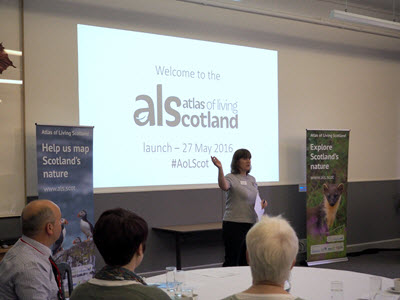
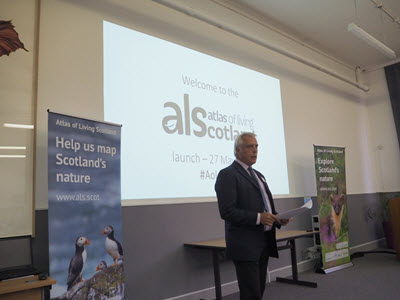
The Welcome Address was given by Ed Mackey, (Head of Knowledge Management, Scottish Natural Heritage (SNH)) on behalf of SNH who are a partner in the NBN Atlas Scotland project. Ed, standing in for Dr Susan Walker, Deputy Chair of SNH, paid tribute to the late John Sawyer, and his vision to develop the Atlas as the NBN platform. He emphasised that the NBN Atlas Scotland has been made possible by the partnership formed by SNH, Scotland’s Environment Web (SEWeb), the Atlas of Living Australia and the Commonwealth Scientific and Industrial Research Organisation of Australia (CSIRO), Scottish Environment Protection Agency (SEPA), the NBN Trust, RSPB and the Scottish Biodiversity Information Forum (SBIF), with funding from the SEWeb LIFE+ project and SNH.
Following the Welcome Address, six speakers representing the project partners and the NBN Atlas Scotland user group presented talks on different aspects of the Atlas. The Keynote Address was given by Dr Jo Judge, Chief Executive Officer, NBN Trust, welcomed by Ed in her first week in post. Jo’s enthusiasm and excitement about the Atlas was clearly demonstrated as she positioned the Atlas at the heart of the NBN’s Strategy and Action Plan 2016-2020, and emphasised the importance of the National Biodiversity Network partnership for data sharing.
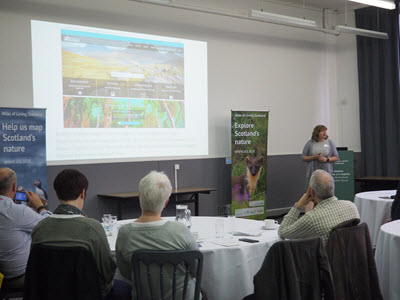
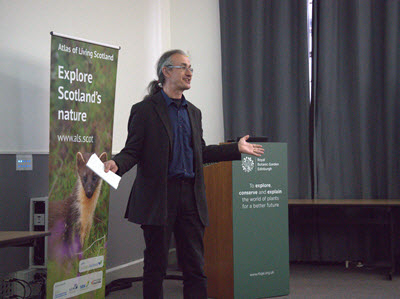
Our next speaker, Roddy Fairley, NBN’s Trustee in Scotland, and Strategy Manager for SNH, took us on a journey describing the development of the Atlas in Scotland, from the first meetings with the developers of the Atlas of Living Australia, through the creation of the Scottish partnership and the funding opportunities that made it possible for the Scottish Atlas to be developed as the first in the UK, to today’s launch of a website that will continue to grow and develop.
Dave Martin, CSIRO, and the developer of the NBN Atlas Scotland, was next to speak, and demonstrated some of the functions of the Atlas. Looking at the species pages he outlined the overview, image gallery, records listing and maps that result from a search by species. He also expertly demonstrated the statistics that can be extracted from the records, such as breakdown of species by habitat, vice-county, data partner, dataset and by dates (decade, month and since 1990). Dave then continued to show how it is possible to explore by area, map by different filters, map using grid squares rather than points, and map species lists in combination with spatial layers.
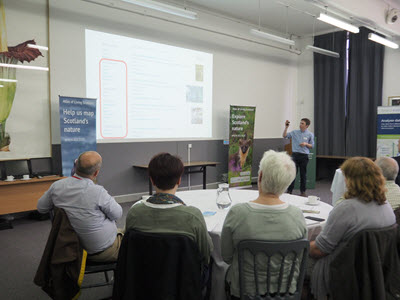
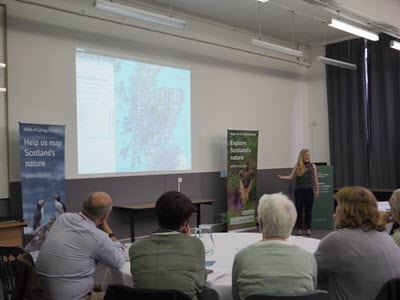
Following Dave, Ella Vogel, NBN Projects Development Officer, expanded on data sources and capabilities of the Atlas, focusing in particular on the spatial layers and ways of mapping the data. Ella gave a step-by-step demonstration of how to map greenshank against blanket peat soils, followed by the mapping of great spotted woodpecker against ancient woodland. The Atlas will make available data on protected areas, habitats, soils, climate, landscape and geology for analysis against species records. Upload of the layers is ongoing and the audience was asked to let us know if there are any particular layers they would like to have available.
Our next speaker, Gill Dowse, Knowledge and Evidence Manager at the Scottish Wildlife Trust (SWT), provided a user’s perspective on the new opportunities for data delivery and analysis offered by the Atlas. For an organisation such as SWT the servicing of data requests to staff and volunteers can be very time consuming with several steps involved in servicing the request. The potential for simplification of the data flow by using the Atlas was ably demonstrated, and an additional bonus with this approach is that all available NBN data will be utilised in the request, not just SWT data which is what would be provided otherwise.
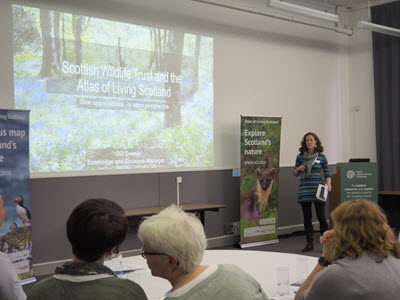
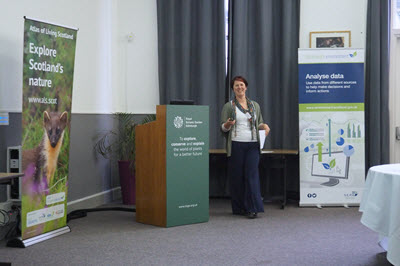
In the final talk Jo Muse, Principal Policy Officer, SEPA, looked at the next steps for Scotland’s Environment Web (SEWeb). The development of SEWeb has brought together environmental and statistical data from different sources for analysis and use in decision-making. SEWeb has facilitated the development of a family of data sites including Scotland’s Soils and Scotland’s Aquaculture. The creation of the NBN Atlas Scotland as part of that family has made possible the analysis of species records against environmental layers, and offers more opportunities for further development.
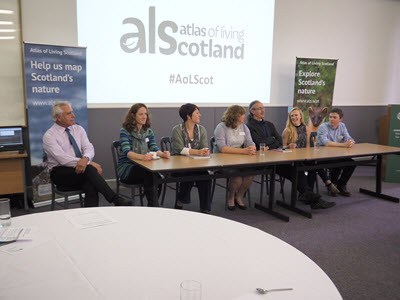
The event concluded with a short panel discussion involving all the speakers. The audience asked the panel to consider the role of the Atlas in Natural Capital discussions. They also suggested additional uses for the data including the identification of under-recorded grid squares, and also the monitoring of change over time. We were encouraged to extend our connections to data partners such as land managers, and the acronym “TCNCS” was coined (to mean Taxonomically Complex Non-Charismatic Species, such as spiders, harvestmen and pseudo-scorpions); it was suggested that more of these groups are included. We were also gently reminded of the importance and value of developing links from the Atlas website to museum and herbarium collections.
The day provided a suitable launch for the NBN Atlas Scotland and it is hoped that the audience went away inspired to explore the interface themselves and to continue to send their comments and feedback. We would like to thank RBGE for providing the facilities and venue, and in particular Elspeth Haston for her time and support with organising the day. Thanks also to all the speakers and to the audience for contributing to the discussion. And finally, thanks to Karlene Hill and baby Rowan Sawyer for coming to the event. Their continued support for the Atlas is heartening.
Links
NBN Atlas Scotland: www.als.scot
Scotland’s Environment Web: http://www.environment.scotland.gov.uk/
Please send any user feedback and comments to: info@als.scot
